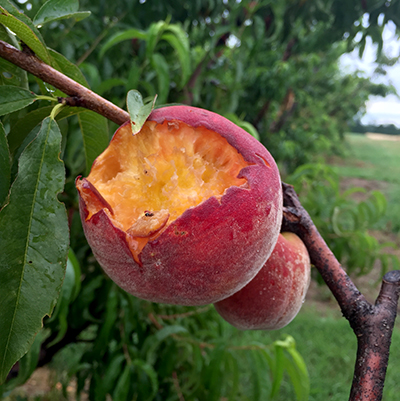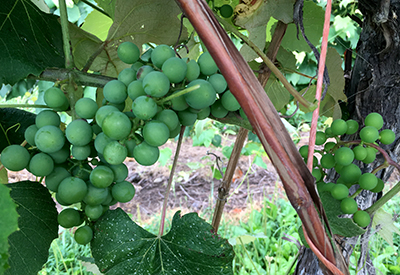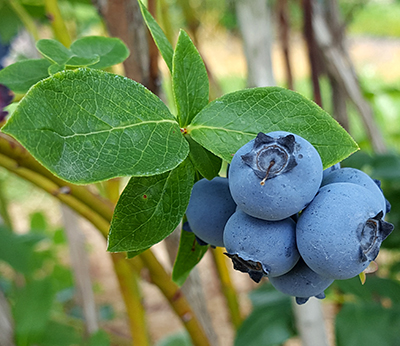Southwest Michigan fruit update — July 11, 2017
Blueberry harvest is in full swing. Cherry harvest is winding down.

Last week was cooler with highs in the 80s. A strong storm crossed the region early Friday morning, July 7, with high winds some rain and no significant hail. Damage was mainly from the high winds. Rainfall was variable and ranged from 0.2 to 0.4 inch of rain.
Another storm front moved through the area early Monday, July 10, with much more rain. Rainfall totals from Monday’s storm ranged from less than 0.5 inch to almost 2 inches.
For the week, most areas received between 0.5 inch and less than 1 inch of rain. Comparing this season’s rain across Enviroweather stations in southwest Michigan shows an average of 10 inches. Some sites have received only 5 inches while others received over 14 inches of rain. The potential evapotranspiration has been around 0.20 inch of water a day.
This week will begin humid with highs in the 80s and lows near 70. There is a good chance of thunderstorms Wednesday, July 12, with a cooler, drier weekend. Last week we accumulated 20 growing degree-days (GDD) base 42 every day and 14.7 GDD base 50. We continue to track over a week ahead of normal for heat accumulation for this date.
|
Southwest Michigan GDD summary from Jan. 1 – July 9, 2017 |
|||
|---|---|---|---|
|
Station |
GDD 42 F |
GDD 45 F |
GDD 50 F |
|
Benton Harbor (SWMRC) |
2181 |
1830 |
1340 |
|
Lawton (Lawton33) |
2027 |
1711 |
1250 |
|
Fennville (TNRC) |
1883 |
1577 |
1136 |
|
Average for the SW region |
2047 |
1725 |
1261 |
|
Ave from March 1 |
1951 |
1659 |
1228 |
|
Accumulation last week |
142 |
126 |
103 |
Tree fruit
Japanese beetles continue to appear in more locations. San Jose scale crawlers are out but no damage seen on fruit. Brown marmorated stink bugs are still keeping a low profile in the area. The summer generation is still largely in the immature stage and not yet flying. Damage to crops is still very low. Growers can the Trevor Nichols Research Center's insect trap catches.
Peach and nectarine harvest has begun. Harvest of Desiree, Earlystar are Harrow Diamond are underway. Bird peck damage is a problem. The Michigan State University Enviroweather peach maturity model estimates the start of Redhaven peach harvest in central Berrien County on July 30, and Aug. 4 for the Allegan County area.
Oriental fruit moth trap catch has jumped in some orchards with the peak of the second oriental fruit moth flight. Egg hatch for the second-generation began approximately June 25, and larval damage to peach and apple fruit will be showing up soon. Stink bug and tarnished plant bug damage can increase fruit susceptibility to brown rot.
As fruit begins to color, the need for brown rot protection increases. Rotate classes of fungicides used for brown rot control to avoid resistance problems.

This peach has been partially eaten by birds. Ripening fruit are attractive to birds, providing food and water. Photo by Bill Shane, MSU Extension.
Cherry harvest is ending with late season sweet cherry varieties. Tart cherry harvest is winding down in Berrien and Van Buren counties. Wind whip damage and brown rot are the primary issues. There was some limb breakage and tree damage from recent storms as well as some wind whip to fruit still on the trees.
There is yellowing and leaf drop of older leaves due to cherry leaf spot infections in some orchards. Many growers applied insecticides to protect their fruit from spotted wing Drosophila (SWD).
Plums range from 1.25 to 1.5 inches in diameter. The area plum crop ranges from poor to fair. Early plums are coloring. Self-thinning of fruit is continuing for some blocks. Protect fruit from brown rot and SWD.
Apples range from 1.5 (Gala) to 2.5 (Zestar) inches in diameter. Sooty blotch and flyspeck management is needed as rains wash off fungicide coverage. The Enviroweather sooty blotch and flyspeck model predicts symptoms of these diseases should be appearing on unprotected fruit. Recent winds and rain may spread fire blight in orchards with succulent growth and a history of the disease.
Fruit entries by oriental fruit moth larvae of the second generation should start showing up soon. Codling moth trap catches continue to be generally low, but should increase soon as the second generation of codling moth starts emerging.
Biofix for obliquebanded leafroller based on Trevor Nichols traps was June 5. Obliquebanded leafroller trap catch numbers continue to decline for the first generation. Egg hatch began about 400-450 GDD base 42 after June 5 biofix—the total is now close to 1,000 GDD. Scout for obliquebanded leafroller larvae feeding on terminal foliage and young fruit.
Scout for spotted tentiform leafminer, aphids, white apple leafhopper and European red mites. Woolly apple aphid aerial colonies are becoming easier to find.
Pear (Bartlett and Harrow Sweet) fruit are more than 1.25 inches in diameter. A minimal spray program will help to hold sooty blotch and fly speck in check. Pear psylla levels seem low.
Small fruit
Grape berries are sizing rapidly. Concord and Niagara are at berry touch. Clusters on secondary shoots in frost-damaged vineyards are catching up. Downy mildew and powdery mildew incidence is low. The fruit cluster rachises of all varieties are still vulnerable to infection by downy mildew. V. vinifera berries are still vulnerable to black rot. Otherwise, clusters are now are resistant to new infection of fungal disease until veraison.
Grape leafhopper and potato leafhopper numbers are increasing in some vineyards. Growers are applying treatment for second-generation grape berry moth now. Berry moth egglaying started July 2-3 in most areas. Vineyards with light pressure from berry moth can apply border sprays. Leaf removal, tucking and other canopy management tactics are continuing.

Difference in berry size between fruit on primary shoots, which survived the May 8 freeze (left), and fruit on secondary shoots, which grew after the May 8 freeze (right). Photo by Brad Baughman, MSU Extension.
Blueberry harvest continues moving from the first pickings of early varieties such as Bluetta and Duke to the first pickings of Bluecrop. Machine harvest has begun. Balancing irrigation, SWD sprays and harvest is a complicated task. The tight schedules used to control SWD will also control blueberry maggot.
You also need to focus on disease control. Wet, warm conditions are good for anthracnose fruit rot. Use Enviroweather’s anthracnose fruit rot prediction model to assess their risk of infection.

Blueberries are ripening quickly as harvest moves from Duke (pictured here) to Bluecrop and other early mid-season varieties. Photo by Mark Longstroth, MSU Extension.
Strawberry renovation is underway. Protect renovated plantings from potato leafhopper, which stunts plant growth. Irrigate renovated strawberry fields to get good growth for next year.
Bramble harvest continues with black and red raspberries. Black raspberry harvest is winding down. Summer red raspberry will continue for several weeks. Protect fruit from SWD. Raspberries and blackberries are a favorite host for SWD and control is difficult. See the MSU recommendations for SWD control in brambles
Upcoming meetings
Clean Sweep Pesticide Disposal in Berrien County on Wednesday, July 26, is for pesticide materials that have expired, are no longer registered, of unknown content, or otherwise need disposal. Participants must register by July 12 (two weeks before the event) to take advantage and disposal of unwanted pesticides. They are going to open early so Viticulture Field Day attendees can also take advantage of this opportunity. Fill out the registration form or call Jill Adams at 269-983-7111 ext. 8234.
The 28th Annual Viticulture Field Day and Steak Cookout is Wednesday, July 26, at the Southwest Michigan Research and Extension Center. This well-attended, educational event is hosted by the Michigan Grape Society and Michigan State University Extension. Register before July 14 for the early-bird rate.
See also
- Plan to change when dealing with spotted wing Drosophila
- Southwest Michigan fruit update – July 5, 2017
- SDHI fungicides for protecting fruit from brown rot infection
- Two birds with one stone: Codling moth and summer leafroller control
- Rebound of obliquebanded leafroller in tree fruits
- Southwest Michigan grape scouting report for June 27, 2017
- Blueberry maggot flies are flying in southwest Michigan
- Anthracnose fruit rot prediction model to assess risk of infection in blueberries
- Post-bloom fungicide choices in blueberries
- Irrigating Michigan Blueberries
- New Delegate and Entrust labels allow for one-day PHI in bushberry crop



 Print
Print Email
Email
